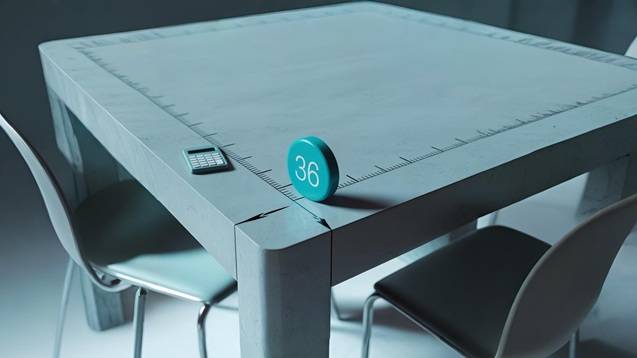Dining Room Table Size Calculator
Find the maximum table size and seating capacity that fits your space
Room & Clearance
Shape & Seating (optional)
Recommended Maximum Table Size
Rectangular (max)
Round (max)
Square (max)

Dining Room Table Size Calculator: Step-by-Step Guide
Designing a dining space that feels roomy, comfortable, and stylish starts with the right table size. This guide shows you exactly how to use the Dining Room Table Size Calculator, the math behind it, and what each choice (clearance, shape, seating) means in the real world. You’ll also see worked examples, standard size ranges, and pro tips.
What this calculator does
- Calculates the maximum table size that fits your room with proper dining room clearance
- Estimates seating capacity based on comfort per person (default 24 inches)
- Compares rectangular, round, and square options
- Supports feet or meters and shows results in ft/in and metric
- Outputs a clear, click-to-reveal breakdown you can share
The formula (simple and transparent)
Choose your per-side clearance (chairs + walking space). Common guidance:
- Good: 36 inches (3 ft) per side
- Busy walkways: 42–48 inches per side
Max table dimensions:
- Max Table Length = Room Length − 2 × Clearance
- Max Table Width = Room Width − 2 × Clearance
- Max Round Diameter = min(Room Length, Room Width) − 2 × Clearance
Seating estimates:
- Comfort per person (edge space): default 24 inches
- Rectangular: seats per long side ≈ floor(Length ÷ 24); double it for both sides, then +2 if width ≥ 36–40" and you plan to seat at the ends
- Round: seats ≈ floor(π × Diameter ÷ 24)
- Square: seats ≈ 4 × floor(Side ÷ 24), tempered by typical ranges for realism
Step-by-step: how to use the dining table size calculator
- Measure your room
- Measure the length and width of the usable dining area. If you have built-ins (buffet, hutch), measure the open space after those.
- Choose your clearance per side
- 36" per side is a comfortable baseline (works out to subtracting 6 ft in total across each dimension).
- If your space functions as a busy corridor, try 42–48" per side.
- Pick units and shape preferences
- Use ft or m. The dining room table size calculator (dining room table size calculator) outputs in both ft/in and metric.
- Select table shape (Rectangular vs Round vs Square).
- For rectangular tables, decide if you’ll seat at the ends (requires ~36–40" width).
- Adjust comfort per person (optional)
- Default is 24" per diner (great for everyday comfort).
- Tight fit: 22" per diner (cozy).
- Luxe spacing: 26–28" per diner (holiday spreads, armchairs).
- Click Calculate
- See your maximum table sizes for each shape and an estimated seating count.
- Review the breakdown to verify room size, clearance, and per-diner edge used.
Worked examples
Example 1: Classic apartment dining area (feet/inches)
- Room: 12 ft × 10 ft
- Clearance: 3 ft per side (36")
- Shape: Rectangular, seat at ends = Yes
- Per person: 24"
Math:
- Max Length = 12 − 6 = 6 ft (72")
- Max Width = 10 − 6 = 4 ft (48")
Seating estimate:
- Long sides: floor(72 ÷ 24) = 3 per side → 6
- Ends allowed (width 48" ≥ 36") → +2
- Total ≈ 8 (fits like a snug holiday setting; everyday comfort is 6)
- Round option: min dimension is 10 ft → Diameter = 10 − 6 = 4 ft (48")
- Seats ≈ floor(π × 48 ÷ 24) ≈ floor(6.28) = 6 (typical comfort for 48" is 4; 6 is tight)
Takeaway: A 72" × 48" rectangular table fits; 6 daily, 8 on occasion. A 48" round is great for 4–5 daily, 6 tightly.
Example 2: Open-plan dining (metric)
- Room: 4.2 m × 3.4 m
- Clearance: 1.0 m per side
- Shape: Rectangular, seat at ends = Yes
- Per person: 24" (≈ 61 cm)
Math:
- Max Length = 4.2 − 2.0 = 2.2 m (≈ 86.6")
- Max Width = 3.4 − 2.0 = 1.4 m (≈ 55.1")
Seating estimate:
- Long sides: floor(86.6 ÷ 24) = 3 per side → 6
- Ends allowed (55" width) → +2
- Total ≈ 8 seats
- Round option: Diameter = min(2.2, 1.4) = 1.4 m (≈ 55")
- Seats ≈ floor(π × 55 ÷ 24) ≈ 7 (real-world comfort ≈ 6–7)
Standard dining table dimensions sizes by seating (quick reference)
| seating capacity | Rectangular Table (Length x Width) | Round Table (Diameter) | Square Table (Side Length) |
|---|---|---|---|
| 4 people | 48"–60" L x 30"–36" W | 36"–48" | 36"–48" |
| 6 people | 60"–72" L x 36"–40" W | 48"–60" | 48"–60" |
| 8 people | 72"–96" L x 40"–44" W | 60"–72" | 60"–72" |
| 10 people | 96"–120" L x 44"–48" W | N/A | N/A |
| 12 people | 120"+ L x 48"+ W | N/A | N/A |
Design guidelines you shouldn’t skip
- Traffic flow: Allow 42–48" walk space behind seated guests on main paths.
- End seating: Comfortable at table widths ≥ 36–40".
- Legroom: Ensure 25–26" from floor to table apron for knee clearance.
- Height: Standard table height is 28–30" (71–76 cm), pairs with most dining chairs.
Shape matters:
- Rectangular: Best in long, narrow rooms or for larger parties.
- Round: Cozy conversation, great in square/smaller rooms; watch pedestal vs. legs.
- Square: Balanced look in square rooms; grows quickly in footprint for 6–8 seats.
- Chairs: seating capacity by table size Measure chair width (often 18–20" armless; 22–24"+ with arms) and count stable placements per side.
- Extending leaves: If you host occasionally, choose a smaller day-to-day size with extension leaves for holidays.
Common mistakes (and easy fixes)
- Only subtracting 36" once: dining room clearance is per side; subtract it on both sides (total 6 ft).
- Ignoring other furniture: Measure the clear floor area after buffets/hutches.
- Overestimating round table capacity: 48" rounds are comfortable for 4; 6 is tight.
- Forgetting chair arms: Armchairs need extra elbow room; use 26" per person for comfort.
FAQ/ Frequently Asked Questions
How do I calculate the maximum table size for my room?
Max Table Width = Room Width − 2 × Clearance
Max Round Diameter = min(Room Length, Room Width) − 2 × Clearance
How much clearance do I need around the table?
- Busy walkways: 42–48" (107–122 cm) per side
Measure from the table edge to the nearest wall or furniture.
How many inches per person should I allow?
- Tight seating: 22"
- Generous/armchairs: 26–28"
The calculator uses 24" by default; adjust if needed.
How is seating capacity estimated for each table shape?
- Round: seats ≈ floor(π × Diameter ÷ edge-per-person).
- Square: seats ≈ 4 × floor(Side ÷ edge-per-person), tempered by typical ranges for realism.
Can I seat at the ends of a rectangular table?
What are standard dining table heights and legroom?
- Legroom (floor to apron underside): 25–26" (64–66 cm)
Verify chair seat height (typically 17–19") fits comfortably.
Round vs. rectangular vs. square — which shape fits best?
- Round: great in small/square rooms; improves conversation; check base/pedestal for legroom.
- Square: balanced look in square rooms; footprint grows quickly for 6–8 seats.
What chair sizes should I plan for?
- With arms: ~22–24"+ (56–61+ cm) wide
Space chairs so their backs don’t collide when pulled out; use your per-person edge to estimate how many fit on each side.
Do built-ins (buffet/hutch) change the calculation?
What are typical table sizes by seating capacity?
- 6 people: Rect 60–72" L × 36–40" W • Round 48–60" • Square 48–60"
- 8 people: Rect 72–96" L × 40–44" W • Round 60–72" • Square 60–72"
- 10 people: Rect 96–120" L × 44–48" W
- 12 people: Rect 120"+ L × 48"+ W
Can I use meters instead of feet and inches?
Any tips for rugs and extensions?
- Leaves: consider a smaller everyday size with extension leaves for holidays and guests.
You can explore Similar Calculator like this Adu cost calculator 2025.

